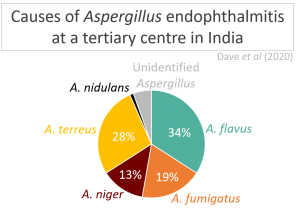Submitted by Aspergillus Administrator on 29 January 2013
Crops are known to be vulnerable to infection by Aspergillus and other moulds when they are stressed. Stressors include lack of water, temperature and insect & wind damage. All are fairly common in areas of the world where extremes of climate occur – in the main these areas are found towards the middle half of large areas of lands, well away from the mediating effects of the sea (location of main crops worldwide).
 |
| Consequences of global warming |
There is some suggestion that at least some of these areas are gradually experiencing higher temperatures and increased drought conditions, and this is thought to be due to global warming caused by burning fossil fuels and releasing excessive CO2 into our atmosphere. If this is true – and most scientists are now in support of this conclusion – then this situation is only going to gradually get worse. Some areas will become warmer, some colder, some dryer – it seems most will experience greater extremes of climate and some of these will stress crops.
Once infected with Aspergillus and other fungi crops tend to accumulate mycotoxin contamination as the same dry conditions tend to also stimulate mycotoxin production. In the US alone in 2011 the value of crops dropped $190 million due to mycotoxin contamination, but finance aside there is a clear threat to the food supply of the world as nearly all of these crops are ultimately for human consumption.
This article points out two threats in particular. In developing countries testing of crops for mycotoxins isn’t extensive and there have even been allegations that contaminated produce has been sold to those countries as it is cheaper on world markets, and cleaner grain produced in those countries is sold abroad (for higher prices) while the grain that is more contaminated is retained for domestic use. Secondly and possibly of more direct interest to US readers (and those in other developed countries) is that testing of grain and other products for mycotoxins isn’t completely efficient. Some batches of grain are allowed through which exceed permitted levels and as the effects of global warming increase those batches are likely to have more toxins in them. Overall the amount of mycotoxin entering the food production industry is going to rise.
Steps are being taken to reduce the amount of mycotoxins present on stressed plant crops. Inoculating crops with fungi that cannot produce mycotoxins has been successful and the breeding of plants that are resistant to fungal attack (1, 2) is under active development.
News archives
-
Title
Date


